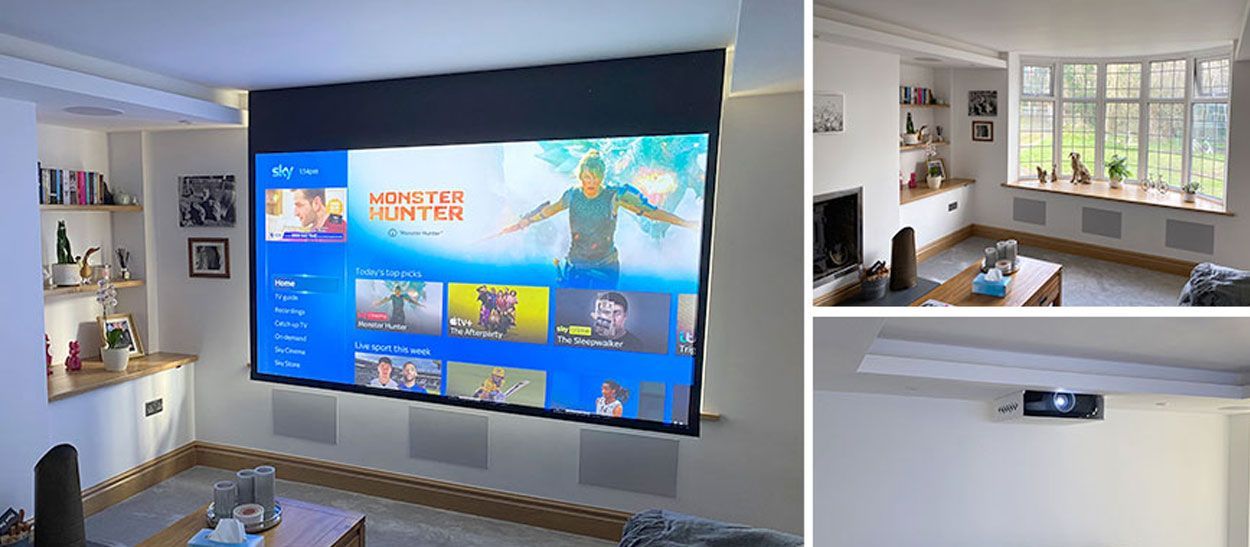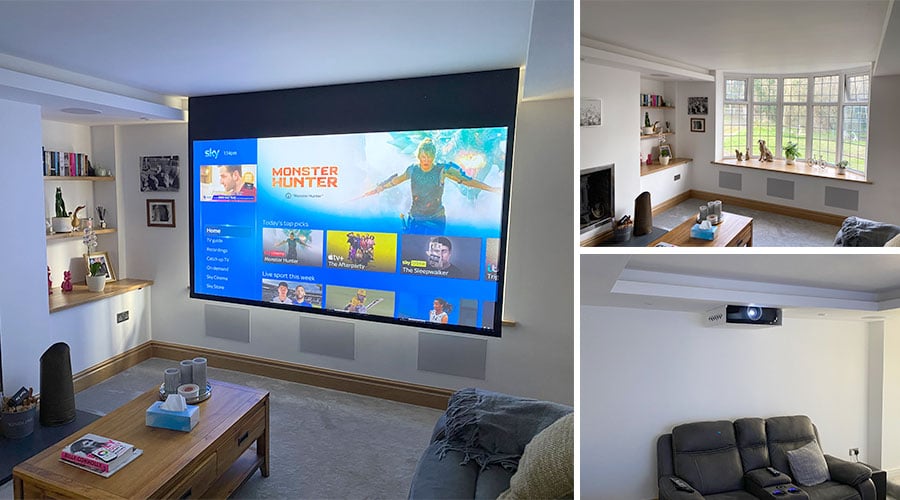The Ultimate Guide to adding a home cinema in your living room
The Ultimate Guide to adding a home cinema into your living room
When we say home cinema most people imagine a dark dedicated room which is solely used for watching movies. But what if you don’t have the extra room for a dedicated home cinema room, or you don’t want a room to be restricted to a single use. Can you take your ordinary living room and turn it into a home cinema? The answer is yes!
What is a home cinema?
The first step towards your home cinema dream is to rethink what ‘home cinema’ means. By definition a ‘home cinema’ is a room which recreates the theatre experience at home. So what is that experience we all love so much:
1. The big screen!
One of the reasons we all love movies at the cinema is the immersive feeling you get from such a large screen. Scale has a unique ability to sweep you away. The big screen creates a real focus on the action that simply cannot be recreated on a regular television.
2. Incredible Sound
The second element is the sound. Most people are actually unaware of how much impact the sound systems in a cinema has on your experience. The way movie theatres are able to place sound around you makes you feel like you are in the action
The big screen - TV or Projector?
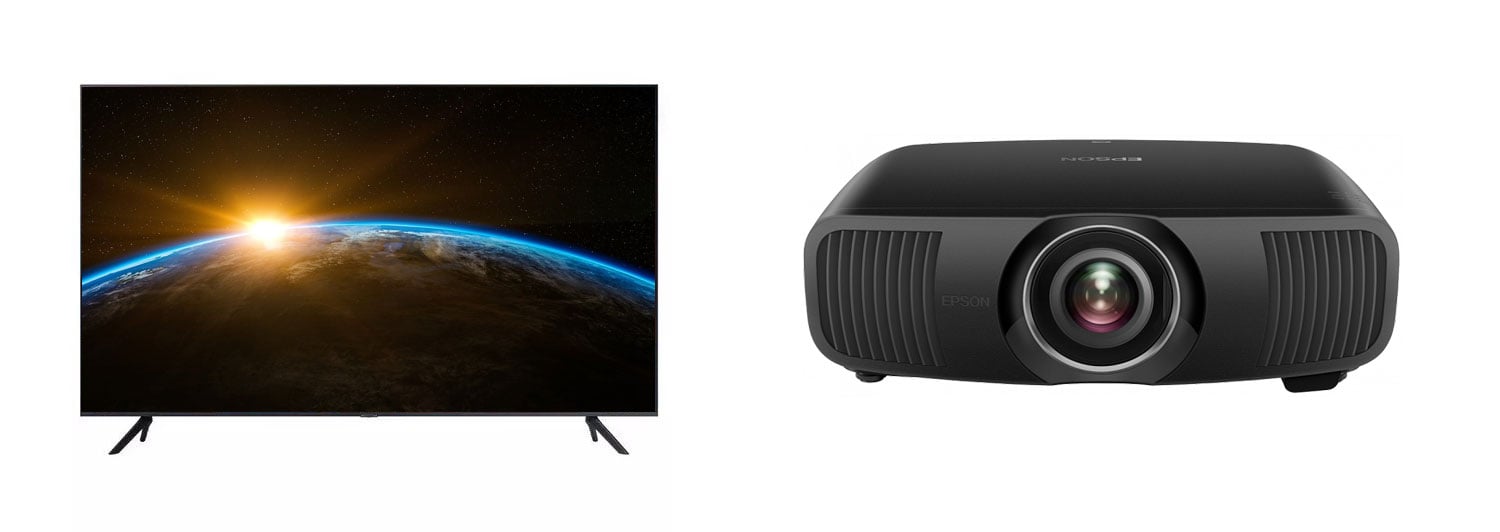

Many people are now conditioned to have a TV. In 2020, around 27 million or 95% of all households in the UK owned a TV set. So it’s no surprise that it can take some convincing for people to ditch the TV and choose a projector instead. This is one of the reasons we wrote a blog addressing this subject check it out here “TV vs Projector”
Lets address some of the pros and cons of TVs and the different options on the market:
Screen Size
Projectors win hands down when it comes to size. The biggest TV you will be able to get your hands on from a regular retailer is around 98” with the most popular size being 85”. Compare this to projector screens which you can easily get in excess of 100” up to 130” from us here at Pure Theatre.
Price
Many people choose a TV because they think it will be a more affordable option. Of course you can get affordable TVs such as an 85” Samsung TV for around £1,799.00. In the same vein you can pick up cheaper projectors and screens. But you need to ask yourself what quality you are getting for that price.
If we compare the same type of quality then you would be looking at TVs which are closer to the £5000 mark and this is only providing you with a 85” screen. Samsung do a 98” TV but this will set you back a whopping £17,999.00. An 86” projector screen would set you back £1,150 team this up with an Epson 9400 projector for £2,500 and you’ve got yourself a pretty impressive setup for £3,650.
"Projectors enable you to watch TV and films on an over 100-inch screen at home, and you don't need to win the lottery to buy one"
Light
The main concern most people have with a projector is whether it will handle light. The projectors of the past would need an almost pitch black room to give you a clear picture.
You should remember that any screen will be affected by direct sunlight even TVs. For TVs this will be in the form of glare and reflections. Most of us have had those bright days where we have to pull the curtains too because its almost impossible to see the screen with the amount of glare.
Glare would not be an issue with a projector screen. The amount of lumens which today's high end projectors have mean they perform impressively well with ambient light. You would be able to watch all of your usual TV shows with the lights in your room switched on. Of course direct sunlight will impact black levels and therefore you would need to put some mild measures in place if you have an excessively bright room.
What is a concealed home cinema?
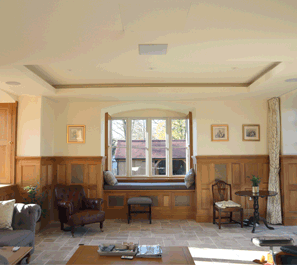

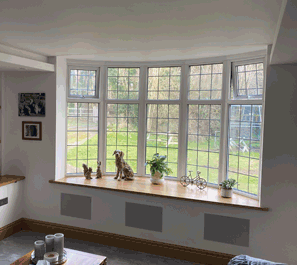

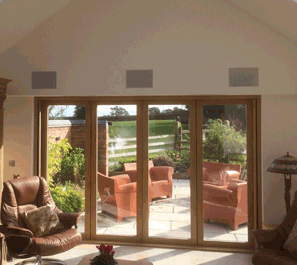

By using motorised projector screens and projector lifts your home cinema can all hide away. So a home cinema no longer needs to be a “A dark dedicated room which is solely used for watching movies” Your living room can be whatever you want it to be and then at the click of a button any room in any home becomes a home cinema.
Projector Screen
Often people will say that they don’t have the room above to fit such a large screen but the majority of motorised projector screens use a roller tube type mechanism. This means that much like a roller blind when retracted they actually need very little space, as little as 11cm in your ceiling void.
The great thing about these types of screens is that they are almost invisible once retracted. This means that you get that all important big screen but only when you want it.
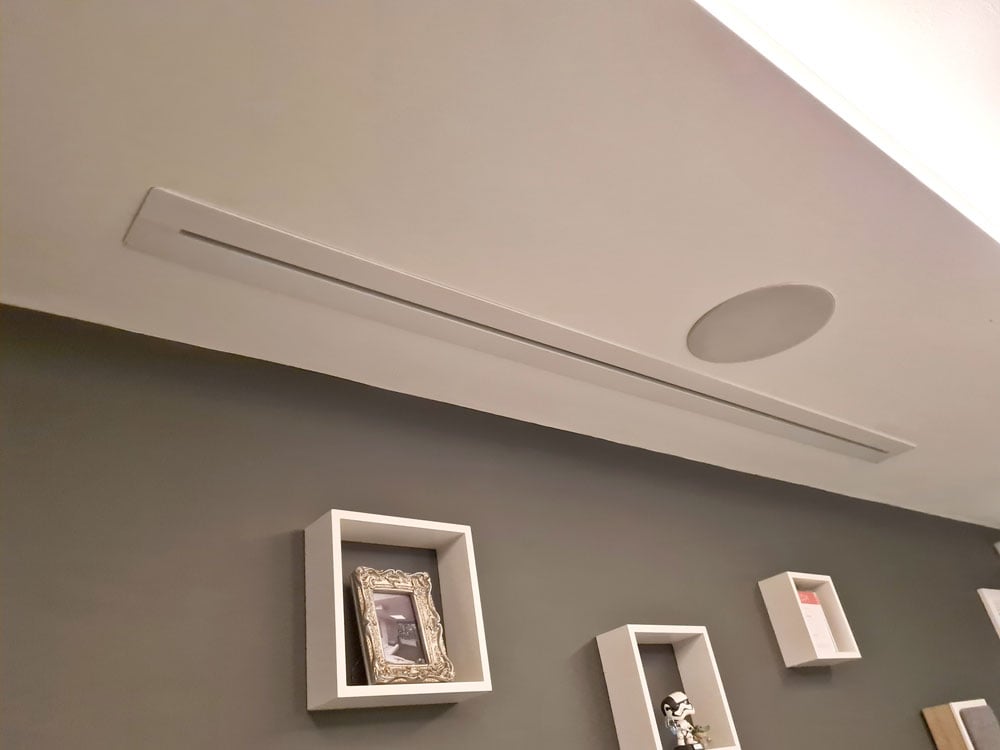

Projector
The other element to consider is the projector itself. Unlike other technology projectors have actually increased in size as time has gone on. This means that many high end projectors are now rather large. So you may not be keen on the idea of having this bulky piece of kit attached to your ceiling.
The answer is a motorised projector lift. Projector lifts encase the projector and recess it into the ceiling when its not in use. This means theres no wires on show and even if you have a black projector it can blend beautifully with your white ceilings.
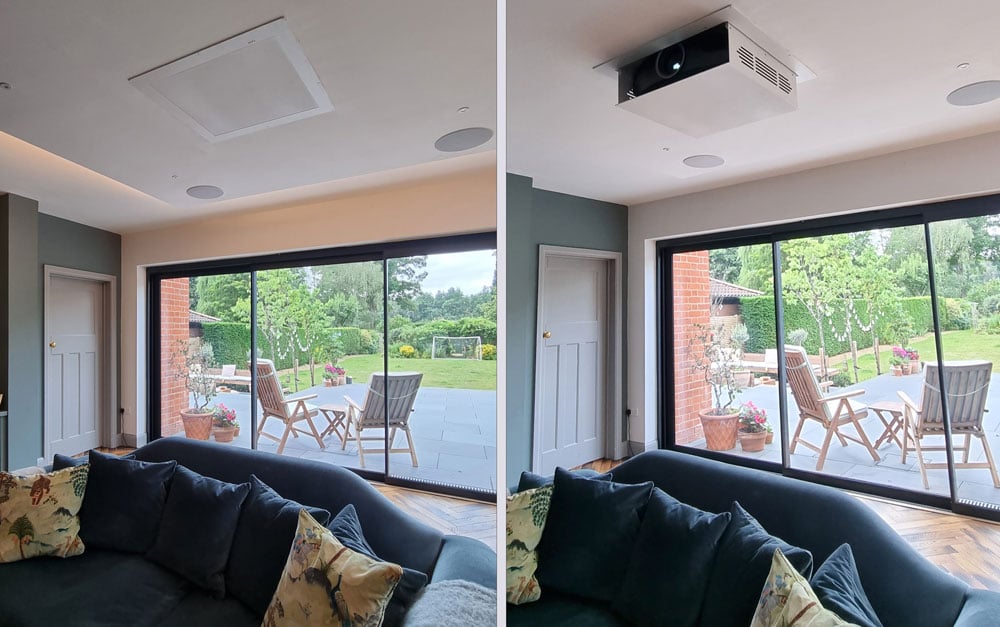

How the concealment works
For more detailed information about how concealment works checkout our blog 3 ways to hide a projector screen
How to choose a projector
The next step in our journey in that Big Screen! A pivotal part of obtaining that cinematic experience at home. So what size should you go for? Some people make the mistake here of simply bigger is better. But actually the screen size should be carefully considered based on your room configuration.
The important factor here is the viewing distance. This is the distance from the projector screen to the main seating area. This is why it is important to have an idea of where your seating will be before you choose a screen size. By using a distance calculator you can select the correct screen size for your room.
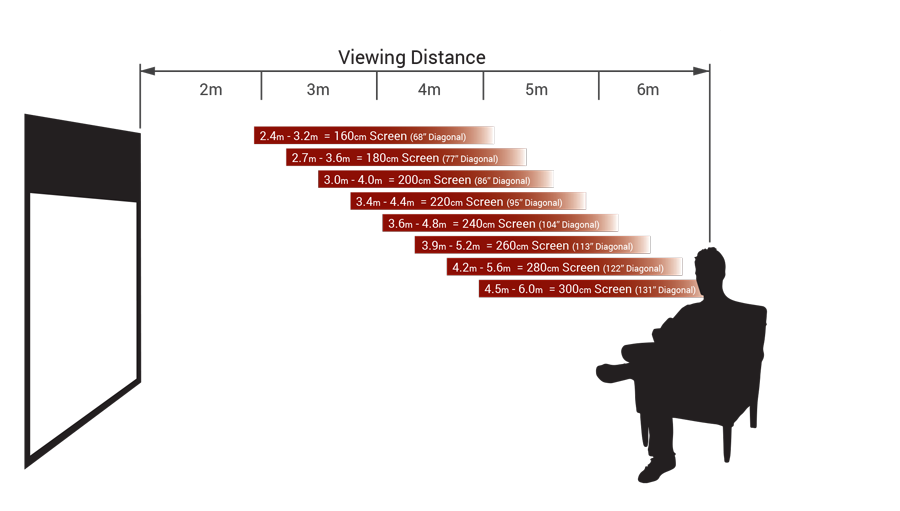

What about the tech itself? Lets start with the projector. There are a wide range of projectors on the market and this is constantly changing. We have a great projector buying guide which will walk you through how to choose the right projector but here is a summary of the things you will be looking at when it comes to a projector:
Resolution
To get the best quality you will be wanting to invest in a projector that has 4k capabilities. You will likely see two terms in your search for a projector Native 4K and 4K E Shift So whats the difference?
Native 4k projectors are those that offer true 4K resolution which is over 8 million pixels. These projectors will offer you fantastic picture quality. The problem however is that Native 4K projectors start at around 5k.
And this is where 4K E Shift comes in offering cheaper alternatives that use what is called pixel shifting. This technology essentially overlays two HD images on top of each other shifted by a half a pixel so quickly the naked eye can’t detect it. This gives the appearance of 4k without the higher price tag.
Many people who we speak to can barely tell the difference and will select these types of projectors. This often frees up budget to improve the sound system in the room or to add in concealment features like a projector lift.
Benq have a great piece in their knowledge base called What is true 4K and does it matter?
Laser vs Lamp
One of the differences between projectors on the market will be whether they have a lamp or laser light source. Many see Laser projector as the preferential choice due to offering longer lasting brightness, lower maintenance and improved color and contrast over similar lamp-based models. But do be aware that once a laser has come to the end of its life it cannot be replaced like the bulbs in the lamp alternatives, rendering it obsolete at this point.
The best way to determine which projector to purchase is to find a retailer which offers demo’s of the different projectors, this way you can see which one suits you. You can book a demo with us here.
Choosing the projector screen size
So for example 100” screen you will need between 3.6-4.8m between the screen and your seating. Screen retailers should be able to assist in the correct size selection using your room measurements.
5
Regular Speakers
1
Subwoofers
2
Height Channel Speakers
So in a 5.1.2 System, which is what most people will go for in their living room we have:
- We have 5 regular speakers a front L/R centre speaker and 2 surround speakers at ear height
- We have 1 subwoofer
- And 2 speakers In the Ceiling
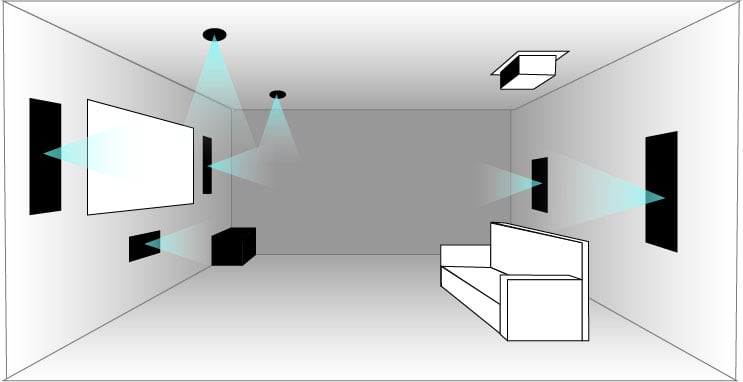

Home cinema speakers explained
This is an often overlooked part of the home cinema but actually it is one of the most important parts. If you remember back to our outline of what it is about that “ experience” that we all love so much, immersive sound is a huge part. When looking at speaker setups you will likely see lots of different configurations i.e 5.1 5.1.2 or 7.1.2 etc.
If you want to fully understand speaker setups then we have a comprehensive home cinema speaker guide, but for the purpose of those looking for speakers for their living room I will quickly explain the number sequence.
In a standard surround sound system you have two numbers. The first number is the amount of regular speakers which will be near to ear height. The second number is the amount of subwoofers in the system.
Sometimes you will see a third number. This last number is the amount of Height channel speakers, usually in ceiling.
In order to make the most of your home cinema setup and finally get rid of your TV connecting it to your favourite devices is essential. This couldn't be easier with an AV Receiver. This is the only piece of equipment that needs to be connected to the projector itself.
Just one Ultra High Speed HDMI cable is required between the projector and AV Receiver.
Then all of your usual kit gets plugged into the back of your AV Receiver. So your sky box, apple TV, xbox playstation or TV sticks can be run through your new home cinema setup.
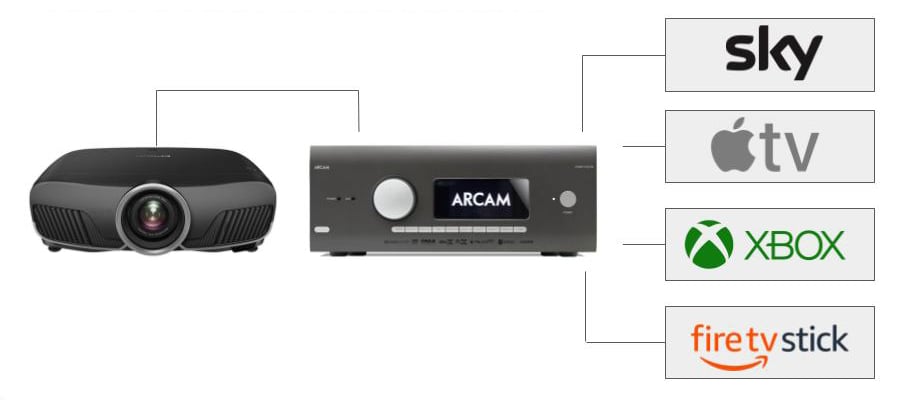

These speakers can be a multitude of different types and this will be down to personal preference.
You can choose to have freestanding speakers if you don’t mind them being on show. There are freestanding speakers which have up firing modules to give you that height channel without the need for ceiling speakers.
Or if you are looking for a concealed option then you can choose in-wall speakers or in-ceiling speakers or a combination of both.
So if we were to look at the wiring setup for a home cinema system in its simplest form:
• Power supply for your projector
• If you have a motorised screen and or projector lift you will need a power supply for these.
• Certified Ultra High speed HDMI cable running from the projector to an AV Receiver (Making sure to get this the right way round)
• Then run speaker wire to all of your speakers in the room and plug into the back of your AV Receiver
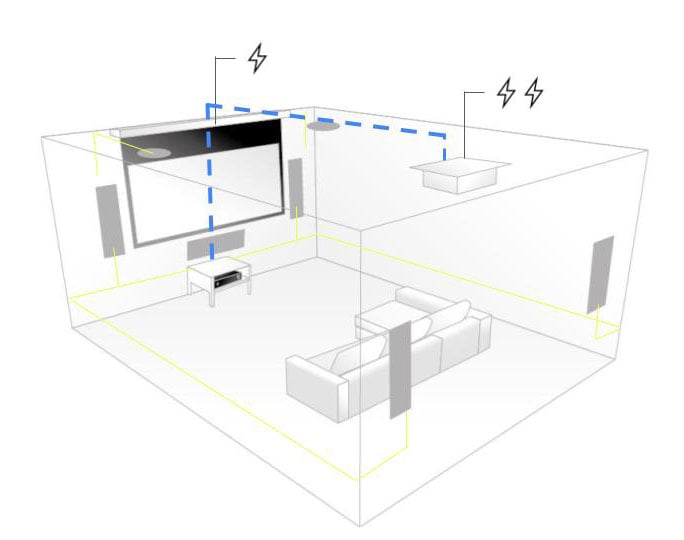

Can I watch what I would on my normal TV?
What most people are most concerned about is whether they will be able to watch all of their usual programs.
Isn't wiring up a home cinema complicated?
This is the part of a home cinema which usually scares people. But it really isn’t as complicated as you may think. Regular electricians will be more than capable of fitting all the wiring needed to plug everything in.
How much will a home cinema in my living room cost?
How much you will spend on a home cinema will depend on your individual budget and which products you choose.
Elements that will affect cost include:
1. Projector selection - home cinema projectors range from 2k to 25k so you can see how this could skyrocket your costs. Try and find a projector that gives you the best quality picture for the most reasonable price. We find that the Epson 9400 is great for the lower end budgets and the Sony 590ES is great for those looking for native 4k.
2. Speaker selection - Speakers are probably the biggest variable when looking at budget. Depending on what kind of sound you are looking for, this could range anywhere from a few hundred to thousands of pounds. But remember that sound will make or break the cinematic feel of the room so if you have to place your budget anywhere put it into the sound system.
3. AV Receiver selection - To make sure you can hook up all your favourite devices you will need an AV receiver. Some AV receivers can be quite expensive so try to think about what you really need for your specific space.
4. Concealment features - For a living room we would definitely recommend a recessed projector screen but a projector lift, which will hide the projector itself, is a feature you can choose to include or not depending on your budget. The lift will set you back around 2.5k so it depends how sleek a finish you are looking for.
5. Installation - A regular builder or electrician will be more than capable of installing your home cinema system. Depending on where you are in the country and whether you are already in the middle of a build will affect the installation costs.
As a general rule we would suggest that for a high quality but simple cinema setup which includes a motorised screen, projector and average speakers you would be looking between 5-8k + installation costs. If you are looking for a completely concealed sleek finish with better audio quality then budget between 8k-15k + installation costs.
Remember you are not alone. If you have decided that you want to go ahead and turn your living room into a home cinema then we can help. If you book a demo then we can guide you through all of the design and product selections taking the stress out of the process. Or if you want us to advise then use our online get a quote form to give us your room details.

 USD $
USD $ EUR €
EUR €